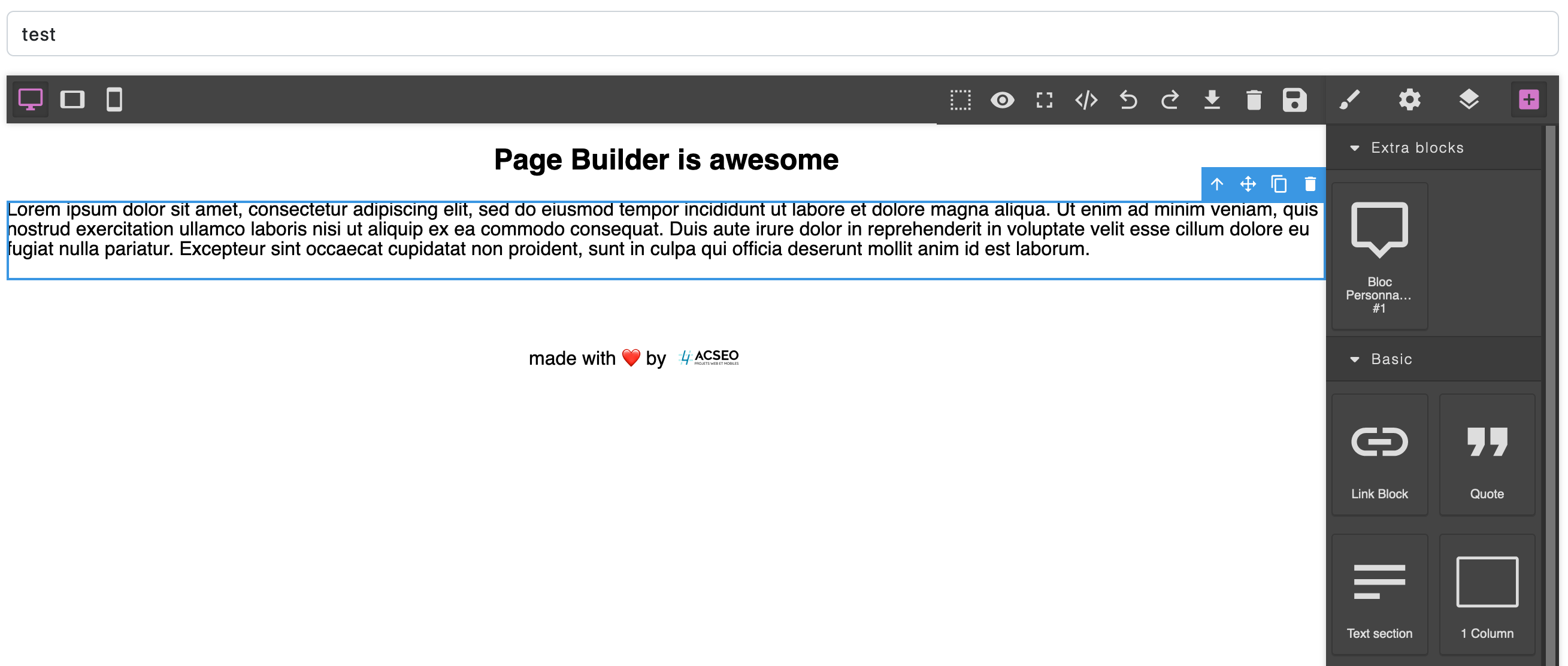acseo / pagebuilder-bundle
This bundle provides a PageBuilder Solution built on GrapesJS.
Installs: 22
Dependents: 0
Suggesters: 0
Security: 0
Stars: 17
Watchers: 4
Forks: 5
Open Issues: 2
Type:symfony-bundle
pkg:composer/acseo/pagebuilder-bundle
Requires
Requires (Dev)
This package is auto-updated.
Last update: 2025-12-19 14:05:40 UTC
README
This bundle provides a PageBuilder Solution built on top of GrapesJS. it provides :
- a Twig Component that you can use in your template with
{{ component('PageBuilder' {'idField' : 'my_field'}) }}. This component will create the PageBuilder area. - a
PageEntity and aPageControllerthat will allow you to store and load the HTML, CSS, and JSON config of the generated Web page. - a Twig Component that you can use to render the page and handle dynamic block rendering
{{ component('PageRender', {'html' : page.html}) }}
Installation
Install the bundle using composer
composer require acseo/pagebuilder-bundle
Enable the bundle in you Symfony project
<?php // config/bundles.php return [ ACSEO\PageBuilderBundle\PageBuilderBundle::class => ['all' => true],
Enable PageController to Load / Save Pages
You can choose to use the default PageController provided in order to load / save the Page entities
To do so, you need to enable the route in your project :
# config/routes/acseo_page_builder.yaml acseo_page_builder: resource: '@PageBuilderBundle/src/Controller/' type: attribute
Update your database to create the Page Entity
With doctrine, according to your strategy :
php bin/console doctrine:schema:update
# OR
php bin/console doctrine:migrations:diff
Configuration
The Bundle configuration allows you to manage how GrapesJS will be loaded, and what additionnal plugins or blocks will be added
Here is an example of a configuration file :
# config/packages/acseo_page_builder.yaml acseo_page_builder: # # GrapesJS Config # # Use this to have only default values # grapesjs: ~ # # Use this to set specific values # grapesjs: js: # Optional : URL of the JS file for GrapeJS. # Default : https://cdnjs.cloudflare.com/ajax/libs/grapesjs/0.21.7/grapes.min.js css: # Optional : URL of the CSS file for GrapeJS. # Default : https://cdnjs.cloudflare.com/ajax/libs/grapesjs/0.21.7/css/grapes.min.css urlLoad: # Optional : Route name used to load Page JSON Content. # Default : acseo_page_builder_load urlStore: # Optional : Route name used to store Page JSON Content. # Default : acseo_page_builder_save pageController: # Optional : Controller used to load / save Pages. # Default : PageController::class # # Plugins Config # Array of name, url, options # plugins: ## Uncomment this example to load grapesjs-preset-webpage #- name: grapesjs-preset-webpage # url: https://cdn.jsdelivr.net/npm/grapesjs-preset-webpage@1.0.3/dist/index.js # # Blocks Config # Declare your custom Blocks # blocks: blocks: latest-articles: label: 'Latest articles' category: 'Extra blocks' media: '<svg viewBox="0 0 24 24"></svg>' content: attributes: 'render': 'latest_articles' traits: - label: 'Number of articles' name: 'articles' type: 'text' value: '5' - label: 'Number of columns' name: 'columns' type: 'text' value: '2' content: '<div class="block">Latest articles. This block will be replaced by latest articles</div>'
Dynamic block rendering
You can create a custom block that will allow you, like the Twig extension method {{ render() }}, to make a call to a Controller inside your page.
To do so, your block must contain an attribute render = 'route_name'. All the attributes of this block will be sent as arguments to the Controller.
The generated output of this fragment will replace the original content of the page.
In our previous example, the custom block latest-articles will generate the following HTML :
Stored HTML in Page Entity :
<!-- ... --> <p>Lorem Ipsum</p> <div id="ijf8l" render="latest_articles" columns="1" articles="3"> <div class="block"> Latest articles. This block will be replaced by latest articles </div> </div> <p>Lorem Ipsum</p> <!-- ... -->
Generated HTML with {{ component('PageRender', {'html' : page.html}) }}
<!-- ... --> <p>Lorem Ipsum</p> <!-- result from the route latest_articles --> <ul> <li>Article 1</li> <li>Article 2</li> <li>Article 3</li> </ul> <p>Lorem Ipsum</p> <!-- ... -->
Usage
In order to work, your Twig page must contain an input field with the page identifier (the URI).
{# templates/my/page.html.twig #} <input type="hidden" id="page_uri" value="hello-world" /> {# OR #} <input type="text" id="page_uri" /> {{ component('PageBuilder', {'idField' : 'page_uri'}) }}
Result
If everything goes well, you should have a screen like this :

